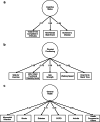Determinants of imminent fracture risk in postmenopausal women with osteoporosis
- PMID: 32613410
- PMCID: PMC7560920
- DOI: 10.1007/s00198-020-05294-3
Determinants of imminent fracture risk in postmenopausal women with osteoporosis
Abstract
In elderly women with osteoporosis, prior fracture, low BMD, impaired physical functioning, poorer general health, and recent falls were all direct predictors of imminent (in next year) fracture risk. Prior fracture, older age, worse health, impaired cognitive functioning, and recent falls indirectly increased imminent risk by reducing physical functioning/general health.
Introduction: This study was designed to examine determinants of imminent risk of osteoporotic fracture (i.e., next 1-2 years) in postmenopausal women.
Methods: This retrospective cohort study used data from Caucasian women age 65 or older with osteoporosis who participated in the observational Study of Osteoporotic Fractures (SOF). We examined potential direct and indirect predictors of hip and nonvertebral fractures in 1-year follow-up intervals including anthropometric measures, bone mineral density (T-score), fracture since age 50, physical function, cognition, medical conditions, recent (past year) falls, and lifestyle factors. Clinically related variables were grouped into constructs via factor analysis. These constructs and selected individual variables were incorporated into a theoretical structural equation model to evaluate factors that influence imminent risk.
Results: Among 2261 patients, 19.4% had a nonvertebral fracture and 5.5% had a hip fracture within 1 year of a study visit between 1992 and 2008. Prior fracture, lower T-scores, lower physical functioning, and recent falls all directly increased 1-year risk of nonvertebral fracture. For both nonvertebral and hip fractures, prior fracture and recent falls influenced risk indirectly through general health, while cognition influenced risk via physical functioning. Age influenced both physical functioning and general health.
Conclusions: Several established risk factors for 10-year fracture risk also played a role in predicting imminent risk of fracture (e.g., T-scores, prior fracture), as did falls, cognition, physical functioning, and general health. Fracture risk assessments should also consider falls and fall risk factors as well as established bone-related risk factors in assessing imminent fracture risk.
Keywords: Fracture; Imminent risk; Osteoporosis; Risk factors.
Conflict of interest statement
Policy Analysis Inc. (PAI) received research funding from Amgen Inc. and UCB Pharma. RLB, AG, and DBC are stockholders and former employees of Amgen Inc. GO and DW are employees of PAI.
Figures



References
MeSH terms
Grants and funding
LinkOut - more resources
Full Text Sources
Medical
Miscellaneous

